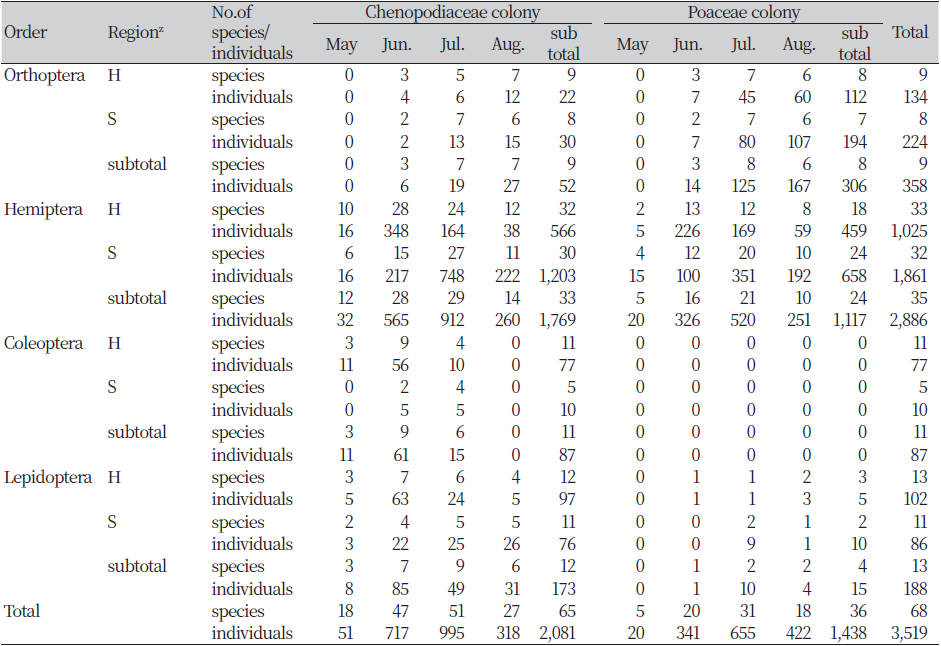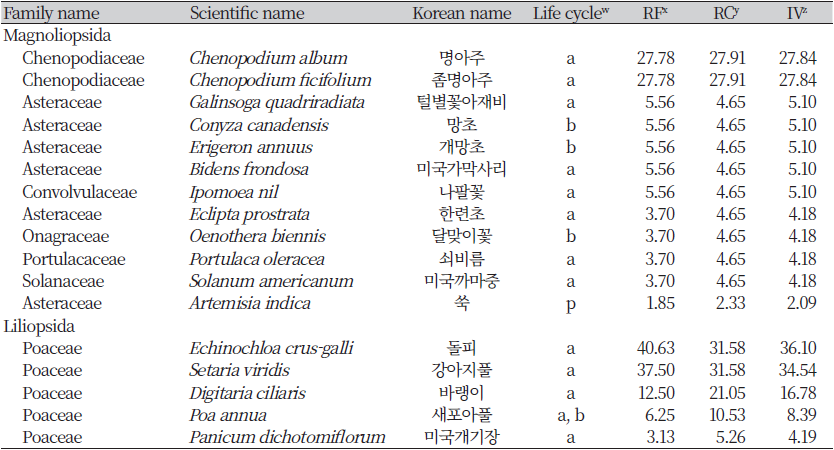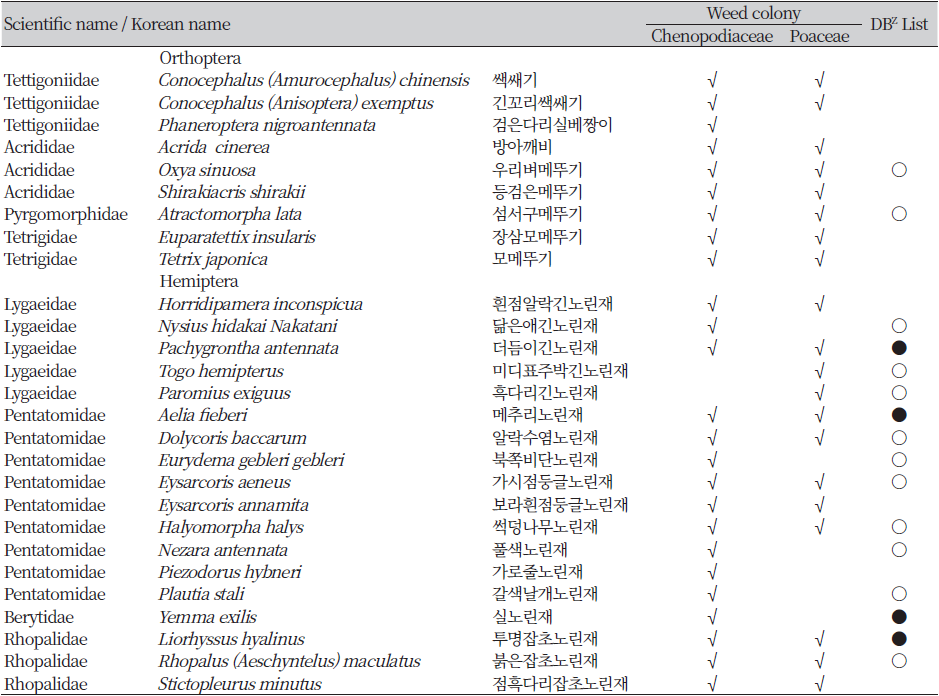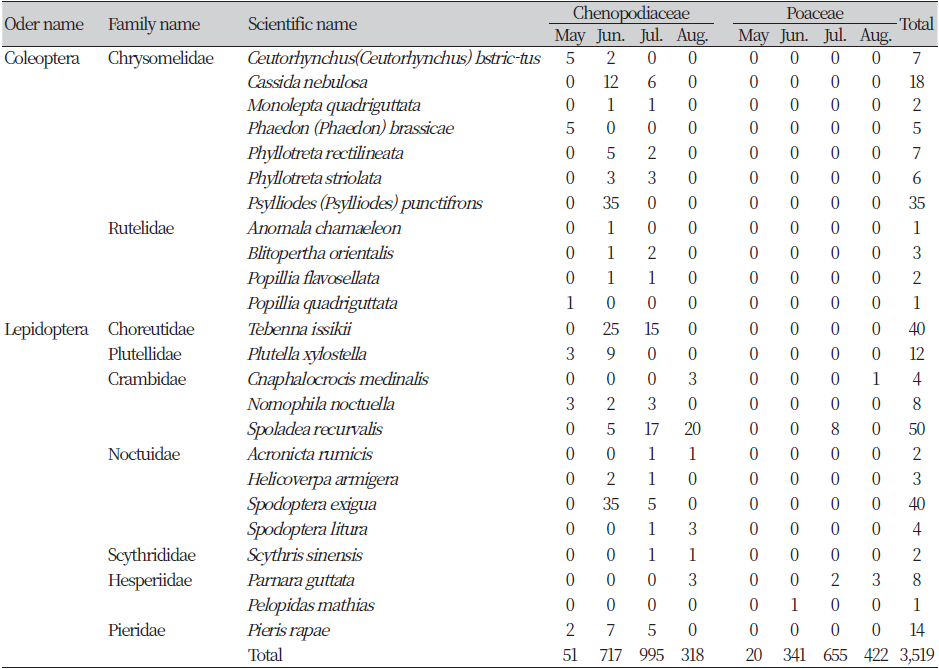서 언
잡초는 작물생산 활동을 방해하는 주요 생물적 저해요소인 동시에 다른 생물들의 서식처 제공, 유전자원 확보, 토양생태계 보존 등에 관여하며 식물이 살아가는 환경 내에서 곤충과 식물병원균 등과 끊임없이 상호작용을 하고 있다. 또한 잡초는 농업생태계에서 작물과 경쟁하며 지속적인 재생산으로 곤충의 서식처와 먹이 제공 등에 관여하여 작물 생산을 저해하는 해충 발생을 증가시킨다(Zou et al., 2016; Neher and Barbercheck, 2019). 이러한 잡초의 직접적인 영향(광, 수분, 양분 등 경쟁)과 간접적인 영향(병해충 매개)은 작물 생산량을 크게 감소시킨다(Soltani et al., 2016 and 2017; Capinera, 2005). 잡초에 서식하는 곤충은 대체로 광식성(廣食性, euryphagous)의 특성을 가지며 경작지 내 발생잡초 종에 따라 곤충의 섭식선호도에 영향을 초래하여 작물생산성을 저하시키게 된다(Capinera, 2005; MacLaren et al., 2020). 우리나라 논 주변에서 발생하는 노린재는 본답으로 이동하기 전에 대부분 화본과 식물에 서식한다. 노린재류는 10과 28종이 기록되었고, 그 중 벼를 가해하는 노린재는 10종이 보고되었다(Goh et al., 1988). 특히 2001년 경기도 김포시 대곶면, 양촌면 일대의 논에서 대량 발생하여 문제가 된 흑다리긴노린재(Paromius exiguus)의 경우 화본과 잡초의 기부에서 월동 후 5~6월까지 잡초인 띠(Imperata cylindricafh) 이삭을 가해하다가 6월 하순 이후 산조풀(Calamagrostis epigeios) 등 중간 기주를 거쳐 벼 출수기에 논으로 이동하여 피해를 준다(Park et al., 2004 and 2009). 이와 같이 작물 해충은 잡초를 서식처로 삼아 중간 기주로 이용하거나 작물에 약제를 처리하는 경우 피난처로 이용하는 경우가 많아 방제에 어려움이 따른다. 그동안 작물 해충에 대한 조사는 광범위하게 이루어져왔지만 작물 주위에 있는 잡초에 발행하는 곤충과 상호작용에 대한 연구는 미비한 실정이다. 한편, 초지에 발생하는 소리쟁이속(Rumex) 잡초에 좀남색잎벌레(Gastrophysa atrocyanea)와 분홍무늬들명나방(Ostrinia palustralis)이 생물적 방제에 효과적이라는 조사결과가 있다(Park et al., 2008). 따라서 본 연구에서는 잡초 군락에 따른 발생곤충상을 조사하여 잡초와 곤충과의 상호연관성을 알아보고 작물생산환경을 이해하는 데 기초자료로 삼고자 실시하였다.
재료 및 방법
조사지 현황
조사대상 경작지는 경남 함안(35°18'00.4"N 128°17'43.6"E)과 산청(35°23'39.3"N 127°54'05.3"E) 지역이며 명아주과 식물이 80% 이상 우점한 명아주 군락과 벼과 식물이 80% 이상 우점한 벼과 군락으로 구분하여 조사하였다. 두 조사지역의 공통 경작작물은 백합강의 삼채(Allium hookeri), 목련강의 치커리(Cichorium intybus) 등이었다. 또한 조사지역 주변작물의 경우 함안에는 백합강의 마(Dioscorea polystachya), 목련강의 우엉(Arctium lappa) 등이었고 산청에는 백합강의 벼(Oryza sativa), 목련강의 뚱딴지(Helianthus tuberosus) 등이었다.
조사 시기
밭작물 경작지에서 발생하는 잡초와 잡초를 가해하는 곤충을 파악하기 위하여 2022년 5월부터 8월까지 월 1회 조사하였다. 매월 25일을 기준으로 실시하였으며 비가 오지 않는 날에 조사하였다. 한편, 경작지를 대상으로 하는 조사이기 때문에 후작물 재배를 위해 조사 시기를 5~8월까지로 하였다.
잡초 초종 조사 방법
잡초 초종 조사는 경남 함안과 산청 밭작물 경작지에서 실시하였다. 조사지점은 목련강(Magnoliopsida)에 속하는 명아주과 식물이 우점하는 군락과 백합강(Liliopsida)에 속하는 벼과 식물이 우점하는 군락으로 구분하여 군락 내 각각 15곳을 선정하여 5 ㎡ (2 m × 2.5 m)에 발생한 잡초 초종을 조사하였다. 출현한 잡초 종에 대해서는 Raunkiaer (1934)의 생활형을 기준으로 일년생, 이년생 및 다년생을 구분하였다. 발생잡초는 각 시기별로 Braun-Blanquet (1964)에 의한 7개 등급(5, 4, 3, 2, 1, +, r)을 기준으로 피도(被度)를 조사하였다. 각 등급별 조사기준은 피도가 조사면적의 76% 이상 출현할 때 5, 피도가 조사면적의 50~75% 출현시 4, 피도가 조사면적의 25~50% 출현시 3, 피도가 조사면적의 5~25% 출현시 2, 개체수는 많지만 피도가 조사면적의 10%이하로 출현시 1, 낮은 피도로 적은 개체수 출현시 +, 극히 드물게 최소 피도의 출현은 r로 나타내었다(Wikum and Shanholtzer, 1978). 주요 조사항목은 초종별 발생빈도, 상대빈도(RF), 피도, 상대피도(RC), 우점도(중요치, IV) 등이다(Curtis and McIntosh, 1950). 본 논문에 사용한 학명과 국명 및 분류체계는 국가생물종목록(CBD-CHM Korea, 2021)에 의거하여 목록을 작성하였다.
Relative frequency( RF ) (%) =  *100
*100
Relative cover ( RC ) (%) = *100
*100
Important value( IV)= 
곤충 조사 방법
조사 대상은 각 지역에서 명아주과 우점 군락과 벼과 우점 군락으로 나누어 해당 군락 잡초에 발생하는 해충을 조사하였다. 조사 방법은 육안으로 관찰되는 곤충을 조사 기록하는 육안관찰법과, 포충망(직경 50 cm)을 이용하여 조사하는 쓸어잡기(sweeping)를 함께 실시하였다. 쓸어잡기는 각 군락의 3개 지점에서 각각 10회씩 실시하였다. 현장에서 종 동정이 어려운 경우는 사진으로 촬영하거나 채집하여 메뚜기, 노린재, 딱정벌레, 나방 등의 각종 도감(Kim, 2013; Ahn, 2010; Ahn and Kim, 2020; Kim and Baek, 2020)과 국가농작물병해충관리시스템 (NCPMS, 2022)을 참고하여 동정하였다. 본 논문에 사용한 학명과 국명 및 분류체계는 국가생물종목록과 한국곤충명집을 따랐다(CBD-CHM Korea, 2021; KSAE and ESK, 2021).
곤충 군집분석
각 군락별로 잡초에 서식하는 해충에 대한 우점도 지수(dominance index), 다양도 지수(diversity index), 풍부도 지수(richness index) 및 균등도 지수(evenness index)와 지점간의 유사도 지수(similarity index)를 계산하였다.
우점도 지수(DI, McNaughton’ dominance index) (McNaughton, 1967)는 각 조사지점의 개체수를 근거로 우점종과 아우점종을 선정하고, 다음과 같은 식으로 산출하였다.

( n 1 : 우점종의 개체수, n 2 : 아우점종의 개체수, N : 총 개체수)
다양도 지수는 Margalef(1958)의 정보이론에 의하여 도출된 Shannon-Wiener function (H')으로부터 변형된 공식을 이용하였다(Pielou, 1969).

( ni : i종의 개체수, N : 총 개체수)
풍부도 지수는 총 개체수와 총 종수만을 가지고 군집의 상태를 표현하는 지수로서 지수 값이 높을수록 종의 구성이 풍부하게 되므로 환경의 정도가 양호하다는 것을 나타낸다. 여기서는 Margalef(1958)의 지수를 이용하여 풍부도를 산출하였다.

( S : 전체 종수, N : 총 개체수)
균등도 지수는 각 지수의 최대치에 대한 실제 값의 비로써 표현되며, 군집 내 종 구성의 균일한 정도를 나타내는 것으로 Pielou(1975)의 식을 이용하여 산출하였다. 균등도 지수는 0~1의 숫자로 표시되며, 지수 값이 1일 경우 그 군집의 균등도가 최상임을 나타낸다.

( H' : 다양도지수, S : 전체 종수)
유사도 지수는 동질성의 정도를 수치화한 것으로써 출현종을 근거로 두 지역 간의 유사성을 나타내며 Sørensen(1948)의 식을 이용하여 산출하였다.

(S: i지점과 j지점의 공통 출현종 수, Si: i지점의 총 출현 종 수, Sj: j지점의 총 출현 종 수)
결과 및 고찰
조사 군락별 발생 잡초
경남 함안 채소 재배지 내 조사구역의 잡초 종 발생빈도를 조사한 결과 목련강(Magnoliopsida)에 속하는 명아주과(Chenopodiaceae)의 명아주(Chenopodium album와 좀명아주Chenopodium ficifolium)가 15곳(100%) 모두 발생하였으며 달맞이꽃(Oenothera biennis)과 미국까마중(Solanum americanum)이 각각 3곳(20.0%)에서 발생하였다. 백합강(Liliopsida)에서는 벼과의 강아지풀(Setaria viridis)이 14곳(93.3%)으로 가장 많이 발생하였고 돌피(Echinochloa crus-galli) 13곳(86.7%), 논피(Echinochloa oryzicola), 새포아풀(Poa annua)이 각각 3곳(20.0%) 순이었다. 경남 산청 채소 재배지 내 조사구역의 잡초 종 발생빈도를 조사한 결과 목련강(Magnoliopsida)에 속하는 명아주과(Chenopodiaceae)의 명아주(Chenopodium album와 좀명아주Chenopodium ficifolium)가 15곳(100%) 모두 발생하였으며 미국가막사리(Bidens frondosa), 망초(Conyza canadensis), 개망초(Erigeron annuus), 털별꽃아재비(Galinsoga quadriradiata), 나팔꽃(Ipomoea nil) 등이 각각 3곳(20.0%)에서 발생하였다. 백합강(Liliopsida)에서는 벼과의 돌피(Echinochloa crus-galli)가 13곳(86.7%)으로 가장 많이 발생하였고 강아지풀(Setaria viridis)이 12곳(80.0%), 바랭이(Digitaria ciliaris) 4곳(26.7%) 순이었다(Table 1).
경남 함안 지역의 채소 재배지 내 잡초 조사구역에서는 총 18종의 목련강(Magnoliopsida)에 속하는 잡초가 발생하였으며 국화과(Asteraceae) 8종, 명아주과(Chenopodiaceae) 2종, 십자화과(Brassicaceae) 2종, 가지과(Solanaceae), 괭이밥과(Oxalidaceae), 바늘꽃과(Onagraceae), 삼과(Cannabaceae), 쇠비름과(Portulacaceae), 현삼과(Scrophulariaceae) 등이 각각 1종씩 발생하였다. 발생 종은 국화과가 가장 많았으나 명아주과의 명아주(Chenopodium album와 좀명아주Chenopodium ficifolium)의 중요치가 각각 21.6으로 가장 우점하는 잡초 종으로 확인되었으며, 그 다음엔 달맞이꽃(Oenothera biennis), 미국가막사리(Bidens frondosa), 미국까마중(Solanum americanum), 털별꽃아재비(Galinsoga quadriradiata) 등의 중요치는 각각 4.78로 뒤를 이었다. 백합강(Liliopsida)에 속하는 잡초 7종은 모두 벼과(Poaceae)로 조사되었으며 강아지풀(Setaria viridis)의 중요치가 34.64로 가장 우점하는 잡초 종 이었으며 그 다음 돌피(Echinochloa crus-galli)의 중요치는 33.32로 확인되었다(Table 2).
경남 산청 지역의 채소 재배지 내 잡초 조사구역에서는 총 12종의 잡초가 발생하였으며 국화과(Asteraceae) 6종, 명아주과(Chenopodiaceae) 2종, 가지과(Solanaceae), 메꽃과(Convolvulaceae), 바늘꽃과(Onagraceae), 쇠비름과(Portulacaceae) 등이 각각 1종씩 발생하였다. 함안 지역과 마찬가지로 명아주과의 명아주(Chenopodium album와 좀명아주Chenopodium ficifolium)의 중요치가 각각 27.84으로 가장 우점하는 잡초 종으로 확인되었다. 그 다음은 개망초(Erigeron annuus), 나팔꽃(Ipomoea nil), 망초(Conyza canadensis), 미국가막사리(Bidens frondosa), 털별꽃아재비(Galinsoga quadriradiata) 등의 중요치는 5.10 수준이었다. 백합강(Liliopsida)에 속하는 잡초의 경우 5종 모두 벼과(Poaceae)로 조사되었으며 돌피(Echinochloa crus-galli)의 중요치는 36.10로 가장 우점하는 잡초 종으로 확인되었으며 강아지풀(Setaria viridis)의 중요치는 34.54로 조사되었다(Table 3).
1990년 전국 밭 잡초 조사 결과에서 하계 작물재배지는 바랭이, 쇠비름, 명아주가 우점하는 것으로 조사되었는데(Chang et al., 1990) 본 조사지 함안과 산청에서도 명아주과 식물(명아주, 좀명아주)이 우점하였다. 특히 두 지역 모두 명아주와 좀명아주의 우점도는 다른 종들에 비해 우점도 지수가 월등히 높았다. 경기북부 밭 잡초 조사 결과에서는 고추, 들깨, 콩, 마늘, 고구마, 옥수수 등 다양한 작물에서 돌피가 주요 우점종으로 확인되었는데(Oh, et al., 2014), 이번 조사에서도 벼과 우점 군락에서 우점종은 돌피와 강아지풀이었으며 다른 종들에 비해 우점도 지수가 매우 높았다. 이 두 지역 모두 관행적인 농약 살포의 횟수가 다른 농가보다 적었는데 초종과의 연관성에 대한 상세연구는 향후 추가적인 조사가 필요하다.
조사 군락별 발생 곤충상
경남 함안, 산청 지역의 잡초에서 관찰, 채집되어 동정된 곤충은 총 4목 23과 68종 3,519개체였다. 가장 많은 종수가 조사된 분류군은 노린재목(Hemiptera)으로 총 35종이었고, 나비목(Lepidoptera) 13종, 딱정벌레목(Coleoptera) 11종, 메뚜기목(Orthoptera) 9종순이었다. 개체수는 노린재목이 2,886개체로 가장 많았으며 전체 개체수의 82.0%를 차지하였다. 메뚜기목은 358개체로 전체의 10.2%를 나타내었고 이어서 나비목(5.3%), 딱정벌레목(2.5%) 순이었다(Table 4). 노린재목이 종과 개체수에서 높은 비율을 보이고 있는 것은 다른 목에 비해 잡초를 먹이로 하거나 서식처로 이용하는 범위가 넓다고 할 수 있다. 잡초에서 발생하는 곤충 분류군은 이번 조사에서 메뚜기목, 노린재목, 딱정벌레목, 나비목 등 4목이었는데 이는 1992년 국화과의 잡초가해 곤충에서 조사된 4목과 일치한다(Choo et al., 1992).
|
Table 4. The number of species and populations of insects inhabiting weeds in Haman and Sancheong, Gyeongnam, Korea. 
|
각 지역에서 명아주과 우점 군락에서는 총 65종 2,081개체가 확인되었고, 벼과 군락에서는 총 36종 1,438개체가 확인되었다. 명아주과 우점 군락에서 가장 많은 종수가 조사된 분류군은 노린재목으로 33종이 확인되었고, 나비목 12종, 딱정벌레목 11종, 메뚜기목 9종순이었다. 이는 명아주과 우점 군락과 벼과 우점 군락을 모두 합친 순서 결과와 일치한다. 개체수는 노린재목이 1,769개체로 가장 많았고, 나비목 173개체, 딱정벌레목 87개체, 메뚜기목 52개체 순이었다. 벼과 우점 군락에서 가장 많은 종수가 조사된 분류군은 노린재목으로 24종이었고, 메뚜기목 8종, 나비목 4종순이었으며, 딱정벌레목은 조사되지 않았다. 개체수는 노린재목이 1,117개체로 가장 많았고, 메뚜기목 306개체, 나비목 36개체 순이었다(Table 5). 명아주과 우점 군락이 65종으로 36종인 벼과 우점 군락보다 약 두 배 정도로 종수가 많다. 이는 명아주과 우점 군락에 다양한 과에 속하는 잡초들이 있어 이를 기주로 하는 곤충 종수가 많고, 벼과 우점 군락에는 벼과에 속하는 잡초만 있고, 딱정벌레목은 한 종도 조사되지 않아 곤충 종수가 적은 것으로 사료된다. 또한 나비목의 경우도 벼과 식물을 기주로 하는 종은 목련강(Magnoliopsida)에 속하는 식물을 기주로 하는 종보다 다양성이 떨어진다. 명아주 우점 군락에는 메뚜기목, 노린재목, 딱정벌레목, 나비목이 모두 조사되었지만 벼과 우점 군락은 딱정벌레목이 조사되지 않았고, 개체수는 메뚜기목과 노린재목에 집중되어 조사되었다. 한편, 메뚜기목의 경우 종수는 각 군락별로 비슷하였지만 개체수는 벼과 우점 군락이 훨씬 많았다.
각 군락에서 조사된 월별 종수를 보면 명아주과 우점 군락에서는 7월에 51종으로 가장 많았고, 6월(47종), 8월(27종), 5월(18종) 순이었다. 벼과 우점 군락에서는 7월에 31종으로 가장 많았고, 6월(20종), 8월(18종), 5월(5종) 순이었다. 월별 종수의 경향은 두 군락에서 모두 7월, 6월, 8월, 5월의 순서로 일치하였다. 개체수는 명아주과 군락에서 7월에 995개체로 가장 많았고 6월(717개체), 8월(318개체), 5월(51개체) 순이었다. 벼과 군락에서는 655개체가 조사된 7월에 가장 많았고 8월(422개체), 6월(341개체), 5월(20개체) 순이었다(Table 5).
|
Table 5. The monthly number of species and populations of insects inhabiting weeds in Haman and Sancheong, Gyeongnam, Korea. 
|
|
ZH: Haman, S: Sancheong |
경남 함안과 산청 지역에서 조사된 전체 곤충의 우점종은 Table 6과 같다. 전체 제1 우점종은 총 3,519개체 중 843개체(24.0%)를 차지한 명아주장님노린재(Orthotylus flavosparsus)였으며 571개체(16.2%)의 홍색얼룩장님노린재(Stenotus rubrovittatus), 203개체(5.8%)의 닮은애긴노린재(Plagiognathus yomogi)순이었다. 명아주과 우점 군락의 제1 우점종은 843개체로 40.5%를 차지한 명아주장님노린재(Orthotylus flavosparsus)였고 닮은애긴노린재(Plagiognathus yomogi), 각시장님노린재(Polymerus cognatus)순이었다. 벼과 군락의 제1 우점종은 260개체(32.7%)를 차지한 홍색얼룩장님노린재(Stenotus rubrovittatus)였고 빨간촉각장님노린재(Trigonotylus caelestialium), 우리벼메뚜기(Oxya sinuosa) 순이었다(Table 7). 명아주 우점 군락에서 명아주과를 기주로 하는 제1 우점종 명아주장님노린재 개체수는 다른 종에 비해 압도적으로 많았는데 6, 7, 8월 모두 많은 개체수가 조사되었고(Table 11), 성충과 약충이 함께 혼재되어 보이는 것으로 보아 연 발생회수가 많은 것으로 생각된다. 벼과 우점 군락에서 제1 우점종인 홍색얼룩장님노린재 역시 6, 7, 8월 모두 많은 개체수가 조사되었다(Table 11). Lee 등(2009)이 경기도 벼 재배지에서 조사한 노린재류에서 세 지역 우점종이 홍색얼룩장님노린재인 것은 본 조사 결과와 일치하였다. 한편, 제3 우점종은 우리벼메뚜기로 우점종이 모두 노린재목인 명아주과 우점 군락과 다른 경향을 보였다. 명아주 우점 군락과 벼과 군락에서 공통적으로 조사된 곤충은 총 33종으로 노린재목 22종, 메뚜기목 8종, 나비목 3종이었으나 딱정벌레목은 공통종이 없었다. 명아주 우점 군락에서는 조사되었지만 벼과 군락에서 조사되지 않은 종은 총 31종이었으나 벼과 우점 군락에서 조사되었지만 명아주 군락에서 조사되지 않은 종은 미디표주박긴노린재(Togo hemipterus), 흑다리긴노린재(Paromius exiguus), 제주꼬마팔랑나비(Pelopidas mathias) 3종뿐이었다(Table 8).
이번에 조사한 잡초에 발생하는 곤충 68종 중 31종은 국가농작물병해충관리시스템(NCPMS, 2022) Data Base(농촌진흥청 발간 자료집 포함)에 농업해충으로 등록되어 있으며 DB에 기록되지 않았지만 논문을 통해 농업해충으로 기록된 12종을 추가로 확인하였다(Lee et al., 2009; Lim et al., 2012; Lim et al., 2010; Kim et al., 2007). 확인 결과 총 68종 중 43종(63.2%)이 기록된 농업해충이었으며 노린재목 25종, 나비목 9종, 딱정벌레목 7종, 메뚜기목 2종이었다(Table 8). 한편, 문헌에는 기록되지 않았지만 이번 연구에서 조사된 종들은 향후 농업해충이 될 가능성이 있어 지속적인 연구와 관찰이 필요하다.
|
Table 7. The dominant species belonging to surveyed at each weeds colony in Haman and Sancheong, Gyeongnam, Korea. 
|
잡초는 인간이 재배하는 작물과 생장을 경합하기도 하지만 작물을 가해하는 해충과 서식처를 공유하는 존재이기도 하다. 재배 작물을 관리하기 위하여 농약 등을 살포하면 해충은 서식처를 잡초로 이동한 후 재배 작물의 상황이 좋아지면 다시 이동하는 양상을 보인다. 본 연구에서 조사된 68종 중 해충으로 기록된 43종 역시 재배 작물로 이동하여 해충이 될 잠재력이 있으며 이는 경작지에서 잡초를 제거해야 하는 이유 중 하나이기도 하다. 명아주 군락에서 우점종인 명아주장님노린재는 명아주과 작물인 시금치나 근대, 비트 등을 재배할 시 문제가 될 것으로 예상되며, 벼과 우점 군락에서 우점종인 홍색얼룩장님노린재 역시 벼 재배에 문제가 되고 있다. 특히 홍색얼룩장님노린재는 벼 호숙기에 가해할 경우 반점미의 피해가 가장 크다는 연구 결과가 있다(Lee et al., 2009). 한편, 나비목 전체에서 우점종인 흰띠명나방은 명아주과, 백합과, 비름과 등 다양한 식물이 기주이며, 본 조사에는 명아주 우점 군락이 있어 개체수가 많았다. 명아주장님노린재와 흰띠명나방 모두 명아주과를 기주로 하고 있어 명아주과 작물인 시금치, 근대, 비트 등을 재배할 때는 명아주과 잡초 관리를 철저히 해야 할 것으로 사료된다.
조사 군락별 군집 분석
조사 군락별 군집 분석을 월별로 정리한 것은 Table 9와 같다. 우점도 지수(DI)는 명아주 우점 군락에서는 7, 8월이 5, 6월보다 높았고, 벼과 우점 군락에서는 5월, 6월이 7, 8월보다 높아 명아주 우점 군락과 다른 양상을 보였다. 다양도 지수(H′)는 벼과 우점 군락의 5, 6월을 제외하면 도시 및 공단지역과 농경지를 평가한 연구(Choi et al., 2007)에서 건전한 농업지역에 해당하는 다양도 지수 2.1보다 높거나 비슷하였다. 균등도(EI)는 명아주 우점 군락에서 5월에 0.92로 다른 달에 비해 높았고, 벼과 우점 군락은 0.64~0.83까지 대부분 높은 균등도 지수를 보여주고 있다. 군집 내 종 구성의 상태를 보여주는 풍부도 지수(RI)는 명아주 우점 군락이 4.32~7.24로 1.34~4.65인 벼과 우점 군락에 비해 상대적으로 높았고, 월별로는 명아주 군락과 벼과 군락 모두 7월에 가장 높은 지수를 보여주고 있다. 한편 조사 군락별 전체에 대한 군집 분석 결과는 Table 10과 같다. 우점도 지수, 다양도 지수, 균등도 지수 모두 명아주 우점 군락과 벼과 우점 군락 간에 큰 차이가 없었다. 다양도 지수는 명아주 우점 군락과 벼과 우점 군락 모두 건전한 농경지의 다양도 지수인 2.1(Choi et al., 2007)보다 높은 경향을 보였다. 풍부도 지수(RI)는 명아주 우점 군락이 8.38로 벼과 우점 군락의 4.82보다 높았다. 명아주과 우점 군락과 벼과 우점 군락의 유사도 지수는 0.65로 대체로 높은 유사도를 나타내었다. 유사도 지수는 군집 간 20% 미만일 때 서로 이질적인 집단이고 80% 이상일 때 서로 동질적인 집단으로 본다(Whittaker, 1956). 두 군락이 비교적 높은 유사도를 나타낸 것은 벼과 우점 군락에서 조사된 종의 대부분이 명아주 우점 군락에서 조사된 것과 관련이 있다. 재배 포장이 동일하다면 잡초에 발생하는 곤충들은 종수에 차이는 있지만 목련강이나 백합강 모두 서식처를 서로 공유하는 것으로 사료된다.
잡초와 곤충은 동적인 상호작용을 하며 특히 곤충의 아랫턱(하악,下顎, mandible) 구조에 따른 섭식패턴과 잡초가 발산하는 화학물질(alleochemicals)의 영향으로 먹이활동 특성이 나타내는 것으로 알려져 있다(Capinera, 2005). 따라서 작물 재배포장의 주변 잡초에서 발생하는 곤충을 종합적으로 관리할 필요가 있고, 재배작물의 종류(科, family)에 따라 관련 잡초 군락을 체계적으로 방제해야 할 것으로 사료된다.
Acknowledgments
This work was supported by Gyeongsang National University Grant in 2021~2022 to Sung Hwan Choi.
Authors Information
Soo Jeong Ahn, Agricultural Corporation ERANG Co., Ltd., CEO
Sung Geun Lee, Division of Horticulture, Gyeongsang National University, Master Student
Hyung Woo Kim, Division of Horticulture, Gyeongsang National University, Master Student
Jeum Kyu Hong, Division of Horticulture, Gyeongsang National University, Professor
Jeung Joo Lee, Department of Plant Medicine, Gyeongsang National University, Professor
Sung Hwan Choi, Division of Horticulture, Gyeongsang National University, Professor












